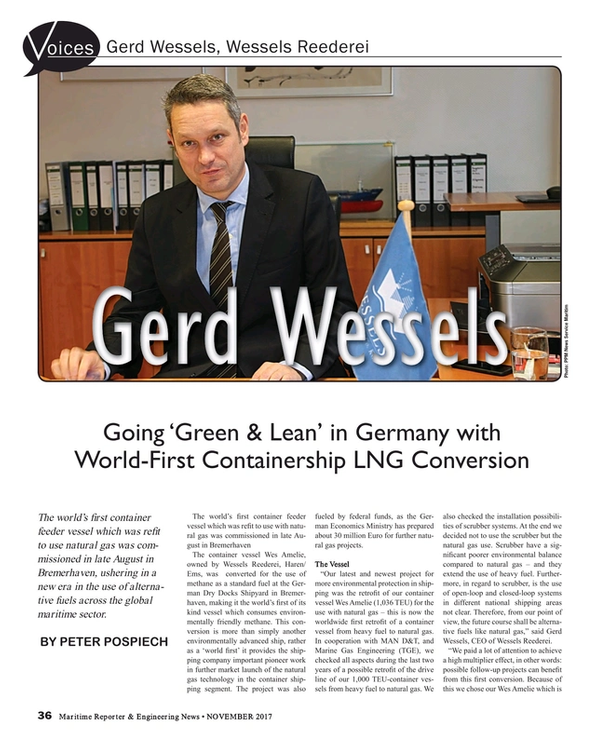
Inside the World's First LNG Containership Conversion
By Peter Pospiech
Going ‘green & lean’ in Germany with the world's first containership converted to run on liquefied natural gas (LNG)
The world’s first container feeder vessel refit to use natural gas was commissioned in late August in Bremerhaven, ushering in a new era in the use of alternative fuels across the global maritime sector.
The container vessel Wes Amelie, owned by Wessels Reederei, Haren/Ems, was converted for the use of methane as a standard fuel at the German Dry Docks Shipyard in Bremerhaven, making it the world’s first of its kind vessel which consumes environmentally friendly methane. This conversion is more than simply another environmentally advanced ship, rather as a ‘world first’ it provides the shipping company important pioneer work in further market launch of the natural gas technology in the container shipping segment. The project was also fueled by federal funds, as the German Economics Ministry has prepared about 30 million Euro for further natural gas projects.
The Vessel
“Our latest and newest project for more environmental protection in shipping was the retrofit of our container vessel Wes Amelie (1,036 TEU) for the use with natural gas – this is now the worldwide first retrofit of a container vessel from heavy fuel to natural gas. In cooperation with MAN D&T, and Marine Gas Engineering (TGE), we checked all aspects during the last two years of a possible retrofit of the drive line of our 1,000 TEU-container vessels from heavy fuel to natural gas. We also checked the installation possibilities of scrubber systems. At the end we decided not to use the scrubber but the natural gas use. Scrubbers have a significant poorer environmental balance compared to natural gas – and they extend the use of heavy fuel. Furthermore, in regard to scrubber, is the use of open-loop and closed-loop systems in different national shipping areas not clear. Therefore, from our point of view, the future course shall be alternative fuels like natural gas,” said Gerd Wessels, CEO of Wessels Reederei.
“We paid a lot of attention to achieve a high multiplier effect, in other words: possible follow-up projects can benefit from this first conversion. Because of this we chose our Wes Amelie which is a 1,000 TEU feeder vessels. This young vessel has been built in large series. They are mostly navigating in the European feeder traffic. Fifteen identical sister ships are available for (similar) a natural gas conversion. All these vessels feature the same main engine type from MAN which have been converted successfully in numerous landside gensets towards the use of natural gas. Thus, valuable practical experience and know-how could be gained in advance for our following conversion. I’m convinced that also vessels from other shipping companies can benefit from the experiences we will have. Future conversion will be profitable with the possible increase of quantity. In general, further gas conversion projects may substantially reduce the budget.”
Christian Hoepfner, GM Wessels Reederei, added, “This particular feeder has been build in large series – there exist 23 sister ships of this SSW Super 1000-type (Schichau Seebeck-Werft) – and Wes Amelie operates currently on charter in the SECA area North- and Baltic Sea. As a mid-market company it is important for us to secure the future of this feeder and our competitiveness with this main engine conversion towards clean natural gas fuel use.”
The New Drive System
Wes Amelie, which measures 152 x 23.4 m, was put into service in 2011. The ship has a container capacity of 1036 TEUs, and it was surveyed and classified during the construction phase by Bureau Veritas (BV). BV is also now the classification society which supervised and controlled the conversion according regulations and ships safety requirements.
Having previously been powered by one MAN 8L48/60 B at 9,000 kW @500 rpm running on heavy fuel oil, the conversion has changed this to MAN 8L51/60 DF dual fuel engine capable of operating on natural gas supplied from one 490-cubic-meter LNG storage tank on the fore deck. The power setting is now 7,800 kW @514 rpm.
While there are several references for this engine type, the Wessel-project is the very first retrofit for a container-vessel for the Augsburg based engine manufacturer, and the conversion of a ship towards natural gas operation is complex. There are differences between the two variants of engines. for instance enough space must be given for the installation of the LNG-tank and the regasification system, reducing load capacity.
The LNG-type “C” tank, supplied by TGE Marine Gas Engineering is positioned on the foredeck and will contain 490 cu. m. of liquefied methane. In total the tank installation cost the ship 29 TEU. Christian Hoepfner: “It was particularly important to us to offer our charterer an environmentally friendly drive system. With this decision we consciously accepted the reduction of load capacity.”
The Engine Tech
“Before we started with the conversion we recorded the complete load profile of the vessel,” said Rainer Runde, Project Manager, Wessels-Reederei. “They prove, that the use of the MAN 8L51/60DF as a main drive for the Wes Amelie is absolutely sufficient. The collected data showed that the reconstructed 8L48/60B at 65 to 75 percent load at about 23 percent of the vessels operating time runs and at 25 to 50 percent at about 43 percent - values which fit perfect into the output profile of the 51/60DF. If we look at the maximum output of the 8L48/60Bs the operating time is about 75 percent. Our journey takes the vessel from Rotterdam, passing the Kiel Canal to different Baltic ports and back to Rotterdam. We bunker preferred LNG in Rotterdam – but the future will show if there are other possible LNG-terminals will exist to take LNG in the Baltic area. The LNG storage will last, at 100 percent load, for about seven days, according a distance of about 2.500 sm – but we never operate under full load.”
MAN Diesel & Turbo supplied all required engine and selected system components as well as the engineering part to convert the former heavy-fuel-oil compatible engine to adapt it to run on liquid and gaseous fuels.
Most the engine components of the combustion chamber as well as the attachments have been exchanged: Cylinder liner with water-jacket area, piston, piston rings and the cylinder heads. This is necessary because of the cylinder diameter increase from 48 to 51 cm. Furthermore all injection components were exchanged respectively newly added. The pilot oil system, which is required for the gas use, was complete new installed. To realize new timings at the 51/60DF engine new cams as well as new turbocharger components were installed. The control of the dual-fuel engine 51/60DF is more complex compared to the heavy-fuel-oil engine. Hence, engine sensors must be converted respectively re-instrumentation was necessary.
MAN supplied all relevant components for the gas use and the pilot oil module on the installation side. TGE Marine Gas Engineering supplied tank and the required LNG-periphery between tank and main engine.
The First LNG-Fill
The initial LNG-filling took place in Bremerhaven by the Hamburg based company Nauticor. Four trucks supplied the LNG. “Thanks to the very good cooperation between ships-crew, the port team of Bremenports as well with our own experts, the first -fill was extremely successful,” said Sonja Neßhöver, MD LNG Portfolio at Nauticor.
Wessels Reederei is forerunner with the use of methane in a container feeder vessel in north-western Europe.
After the first filling Christian Hoepfner said, “We are very happy that the first fill of LNG functioned so smoothly here in Bremerhaven. Here our thanks are once more expressed to the port security Bremerhaven, the Harbor Master’s Office and the LNG supplier Nauticor.”
Mahinde Abeynaike, CEO at Nauticor, concluded, “With the conversion of the Wes Amelie the Wessel Reederei creates important pioneer work for the successful establishment of natural gas as a fuel in the container shipping segment. We gladly support these endeavours and look forward to continuing our collaboration, particularly before the background that in 2018 we will receive our second bunker boat in order to ensure supplies to our customers.”
(As published in the November 2017 edition of Maritime Reporter & Engineering News)
Read Inside the World's First LNG Containership Conversion in Pdf, Flash or Html5 edition of November 2017 Maritime Reporter
Other stories from November 2017 issue
Content
- The Challenge of Marine Asset Appraisal page: 12
- US Navy: Back to Basics page: 16
- The Best Options for Safe Mooring page: 18
- Deck Machinery: Five Stress Areas page: 20
- Five Requirements for Safe Ops page: 22
- How Augmented Reality Technology Could Transform Shipping page: 26
- Eye on Design: C-DRONE page: 28
- IMO Orders Fuels of the Future page: 30
- Voices: Howard Fireman, SVP & CTO, ABS page: 32
- Inside the World's First LNG Containership Conversion page: 36
- Voices: Paul Smulders, CEO, Radio Holland page: 42
- Voices: Rich Merhige, President/Owner, AME page: 44
- A New Breed of Tug page: 54
- Wind Energy Workboats: A US Offshore Build-up page: 60
- Bouchard Set to Celebrate a Century page: 66
- Strategic Marine: Innovative Quality page: 67
- Interferry: Diverse Operations Common Successes page: 68
- Voices: Paulo Cesar P. Freitas, Norsul page: 72
- Managing the New Panamax Containerships page: 80
- Coatings & Corrosion Control Take Center Stage page: 84
- W&O Supply Holds a Steady Course page: 90


